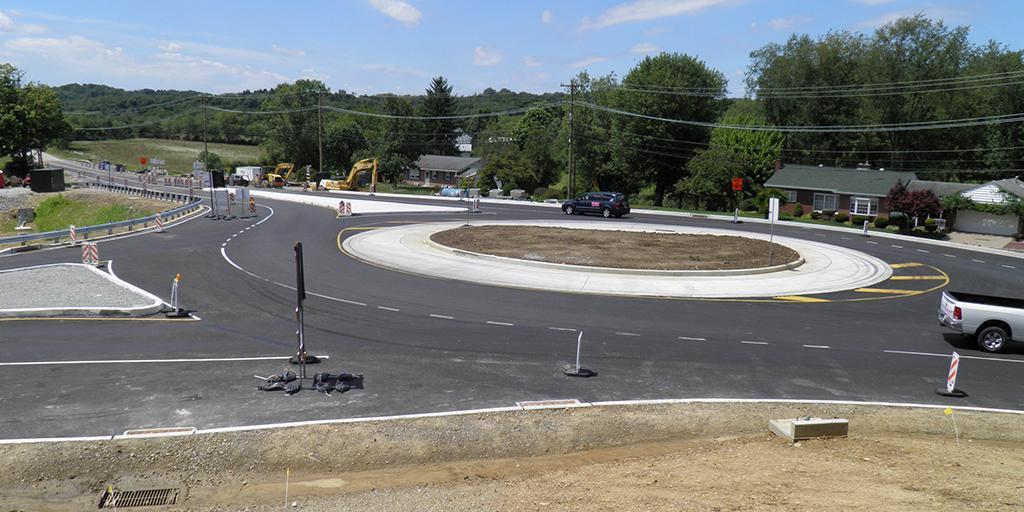
Whenever PennDOT announces a roundabout as part of a road improvement project, we inevitably hear the same concerns: "Why are you installing a roundabout? Didn't New Jersey get rid of theirs? They are so dangerous!"
We can assure you, though, we would never replace an intersection with something that was going to make driving more dangerous. In fact, roundabouts have been proven to be safer than traditional stop-sign or signal-controlled intersections. National studies show that modern roundabouts reduce fatal crashes by up to 90 percent. Modern roundabouts also improve pedestrian safety by allowing people to cross shorter distances of slower-moving one-way traffic due to refuge areas provided between opposing traffic flows.

What about New Jersey then? Modern roundabouts in Pennsylvania are NOT the same as the old-style New Jersey traffic circles, which operate on a different set of principles. For instance, motorists entering traffic circles tend to have the right of way (not as safe), whereas traffic entering a roundabout must yield to motorists already in the circle (much safer). Traffic circles also tend to be much larger, but are inefficient for handling the increased traffic volumes we face today.
Another fun fact? Roundabouts typically carry about 30 percent more vehicles than similarly sized signalized intersections during peak flow conditions. During off-peak conditions, roundabouts cause almost no delay, but traffic signals can cause delay to side streets and traffic turning left from the major street.
Oh, and that raised strip around the center of the roundabout? That's called a truck apron, and large trucks are expected to have their trailer wheels ride over it.
Still have questions on roundabouts? Visit our roundabout page on www.penndot.gov, or email ra-roundabout@pa.gov.
Follow PennDOT on social media — Facebook, Twitter, and Instagram.
ABOUT THIS BLOG
Did you know PennDOT is directly responsible for nearly 40,000 miles of highway and roughly 25,000 bridges? We oversee programs and policies affecting highways, urban and rural public transportation, airports, railroads, ports and waterways, in addition to administering the state's more than 11 million vehicle registrations and 8.8 million driver's licenses.
So, how do we do what we do? And how can we help you travel in Pennsylvania — whether it be for business or leisure — in safe and enjoyable manner? Read PennDOT Way to learn more about the department, what we do, and how and why we do it.
TAGS
50-Year Anniversary, 511PA, Aggressive Driving, Airports, Autonomous Vehicles, Bicycles, Bridges, Child Safety, Community Relations, Construction, COVID-19, Distracted Driving, District 1, District 10, District 11, District 12, District 2, District 3, District 4, District 5, District 6, District 8, District 9, DOTcom, Driver and Vehicle Services, Emergency Responders, Employment, Equity, FAQ Friday, Human Trafficking, Impaired Driving, Innovations, Live Free Ride Alive, Maintenance Monday, Motorcycles, Older Drivers, PA Motorcycle Safety Program, Pedestrians, PennDOT Connects, Ports, Public Transit, Railroads, REAL ID, Road MaP, Roadside Beautification, Rural Roads, Safety, School Buses, Seat Belts, State Transportation Innovation Council (STIC), Sustainability, Teen Drivers, Throwback Thursday, Transportation Funding, Travel in PA, Welcome Centers, Winter, Work Smart, Work Zone, Yellow Dot
LATEST POSTS
PennDOT Continues Sharing, Updating Resources for Local Governments to Pursue Bipartisan Infrastructure Law Funding Opportunities
Norwin High School Wins 2024 ‘Innovations Challenge’
Demo Complete: I-95 CAP Project in Center City Philadelphia
PennDOT Archeologist Connects Past, Present, and Future
Lehigh Valley DUI, Highway Safety Task Force Hosts Law Enforcement Seminar
ARCHIVES
2024
2023
2022
2021
2020
2019
2018
2017

